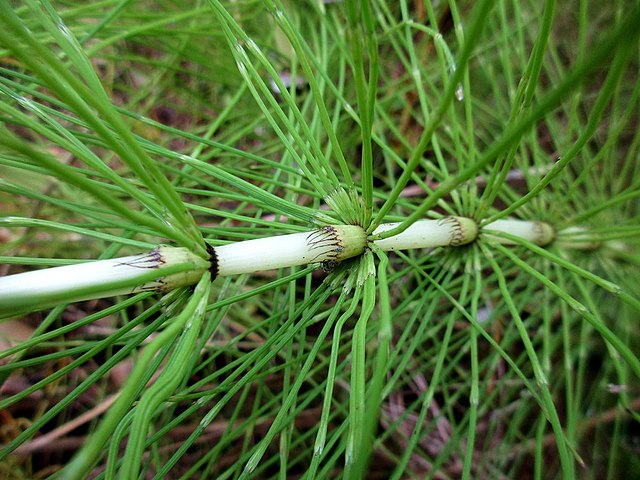Họ Equisetaceae
Ngành dương xỉ – Lớp Equisetopsida – Bộ Equisetales – Họ Equisetaceae
| Equisetaceae
Thời điểm hoá thạch: Kỷ Jurassic[1] đến nay
|
|
|---|---|
 |
|
| Field horsetail (Equisetum arvense) | |
| Phân loại khoa học | |
| Giới (Kingdom): | Thực vật (Plantae) |
| Lớp (Class): | Polypodiopsida (Equisetopsida) |
| Bộ (Order): | Equisetales |
| Họ (Family): | Equisetaceae Michx. ex DC. |
| Chi (Genera) | |
|
|
Equisetaceae, sometimes called the horsetail family, is the only extant family of the order Equisetales, with one surviving genus, Equisetum, which comprises about twenty species.
Equisetaceae, đôi khi còn được gọi là họ đuôi ngựa, là một họ còn sót lại trong bộ Equisetales, với một chi còn sống sót, Equisetum, và được chia ra khoảng 20 loài khác nhau.
Tiến hoá và cấu trúc
Equisetaceae is the only surviving family of the Equisetales, a group with many fossils of large tree-like plants that possessed ribbed stems similar to modern horsetails. Pseudobornia is the oldest known relative of Equisetum; it grew in the late Devonian, about 375 million years ago and is assigned to its own order.
All living horsetails are placed in the genus Equisetum. But there are some fossil species that are not assignable to the modern genus. Equisetites is a “wastebin taxon” uniting all sorts of large horsetails from the Mesozoic; it is almost certainly paraphyletic and would probably warrant being subsumed in Equisetum. But while some of the species placed there are likely to be ancestral to the modern horsetails, there have been reports of secondary growth in other Equisetites, and these probably represent a distinct and now-extinct horsetail lineage. Equicalastrobus is the name given to fossil horsetail strobili, which probably mostly or completely belong to the (sterile) plants placed in Equisetites.
Equisetaceae là họ còn tồn tại duy nhất của bộ Equisetales, một nhóm có nhiều hoá thạch những thực vất giống cây cỡ lớn và thân cây có gân giống như các loại cỏ đuôi ngựa ngày nay. Pseudobornia được biết đến là họ hàng lâu đời nhất của Equisetum, nó từng mọc và cuối kỷ Devon, khoảng 375 triệu năm trước và được xếp riêng thành một bộ.
Tất cả các loại cây đuôi ngựa được xếp vào chi Equisetum. Nhưng một số loài có gân không được xếp vào chi hiện đại này. Equisetites giống như một “đơn vị phân loại kiểu thùng rác” khi xếp chung tất cả các nhóm đuôi ngựa kể cả Mesozoic, nó khá gần gũi và được đảm bảo trong việc xếp vào Equisetum. Mặc dù có một số loài được coi là tổ tiên của các loại cỏ đuôi ngựa hiện đại được xếp chung nhóm, nhưng có những báo cáo đã có sự phát triển thứ cấp so với các loại cỏ đuôi ngựa hiện đại. Equicalastrobus là cái tên được đặt cho loài cỏ đuôi ngựa có gân strobili, loại thường được hoặc mặc định được xếp trong các loại cây thuộc Equisetites.
Tham khảo
- ^ Channing, A.; Zamuner, A.; Edwards, D.; Guido, D. (2011). “Equisetum thermale sp. nov. (Equisetales) from the Jurassic San Agustin hot spring deposit, Patagonia: Anatomy, paleoecology, and inferred paleoecophysiology”. American Journal of Botany. 98 (4): 680–697. doi:10.3732/ajb.1000211. PMID 21613167.
- ^ Christenhusz, M. J. M.; Byng, J. W. (2016). “The number of known plants species in the world and its annual increase”. Phytotaxa. Magnolia Press. 261 (3): 201–217. doi:10.11646/phytotaxa.261.3.1.
- ^ Weber, Reinhard (2005): Equisetites aequecaliginosus sp. nov., ein Riesenschachtelhalm aus der spättriassischen Formation Santa Clara, Sonora, Mexiko [Equisetites aequecaliginosus sp. nov., a tall horsetail from the Late Triassic Santa Clara Formation, Sonora, Mexico]. Revue de Paléobiologie 24(1): 331-364 [German with English abstract]. PDf fulltext



